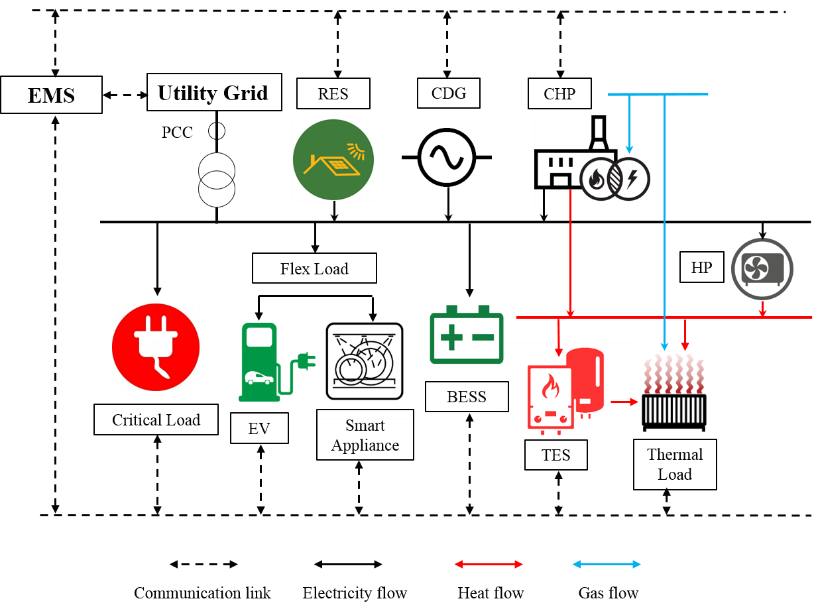Dr Xi Zhang, Research Associate in the Department of Electrical and Electronic Engineering, discusses the role of multi-energy microgrids in strengthening our energy infrastructure resilience and increasing the security of supply. Xi works on Project 4 of IDLES, which considers the resilience and risk management of future whole-energy systems.

We’re expecting to see fundamental transformations in the operational configuration of our urban energy infrastructure over the coming decades. This is due, in part, to the increased urban electric load we anticipate, driven by electrification of the transport sector, cooling/heating technologies, various forms of energy storage technologies, plus advancements in distributed generation and demand-side response. Of particular interest to us in Project 4 of IDLES is how the resilience of this changing energy system can be protected and improved.
Although there is not yet a consensus on the exact definition of resilience with respect to the power system, it is widely accepted that resilience can strengthen the immunity of the power system to ‘low-probability, high-impact’ disruptive events. Put simply, it is the ability of the power system to gracefully degrade the magnitude and duration of an outage and rapidly recover to its normal state.
In the future, resilience will not necessarily be delivered through asset redundancy at the national level, as is traditionally the case, but rather through smart control of multi-energy systems at the local district level, including making use of local backup generation and energy storage options. Smart multi-energy microgrids (Fig.1) will constitute the cornerstone of this future urban energy system.
A microgrid is an integrated energy system consisting of energy generation sources, storage options, and energy users. It can be connected to the main electrical grid or may operate in isolation, as an ‘island’, often in rural environments. Those microgrids connected to the main grid can also disconnect and operate independently if necessary, i.e. if there’s a fault within the main grid.
Microgrid design approaches have largely been addressed for the electricity supply, however there’s a research gap in designing reliable multi-energy microgrids, i.e. those that incorporate power, gas, heat storage, Vehicle-to-Grid (V2G) and other concepts that could play an important role in integrated energy networks. This is a highly challenging research area due to the additional complexity of numerous potential interactions between energy vectors and technologies.
To support such paradigm shift, a fully intelligent and sophisticated coordination of the system through corrective control actions is required.

Due to the effects of climate change and increased cyber-attacks, over 130 major power outages have occurred across the world in the past two decades. Severe disruptive events cripple the power system, impact on public services and can result in danger to life. The power outage of Friday, 9th August, 2019 is one such recent example.
Due to the increased occurrence and severity of power outages in recent years, more attention has become focussed on improving the resilience performance of the power system.
On the one hand, enhancement of power system resilience could continue to be delivered through the redundancy of infrastructure, however this requires huge investment for what are only low-frequency disruptions, thus significantly reducing the capacity utilization rate of assets.
On the other hand, when microgrids island themselves from the main electrical grid, they can continue to supply the local load using various distributed energy resources (small-scale power generation or storage technologies) coupled via strong links between the different energy vectors, thus mitigating against the adverse effects (e.g. frequency drop) posed by the power imbalance of the main grid.

Our recent research has demonstrated that coordinated operation of different energy vectors via multi-energy microgrids can facilitate cost effective decarbonisation, through providing improved flexibility which supports the local network management and the national system operation.
However, the potential benefits of this coordinated operation to enhance the resilience of the urban energy system has not been fully investigated. Understanding these interactions is of huge importance when we consider the future structure of the urban energy network.
In this context, our present work investigates alternative coordination strategies aimed at enhancing resilience of urban energy systems, which includes application of local backup generation, integration of batteries, electric vehicles and inherent thermal storage of buildings to support the local district infrastructure.
Alongside this we are looking at co-optimising operation of local CHP plants and making use of intrinsic thermal storage in the heating/cooling sector. Furthermore, optimal dispatch of local resources (coordinating resources to provide a certain amount of energy/storage while minimising cost) and strategic curtailment/shifting of non-essential loads can significantly enhance the resilience of urban energy systems.
Our next work will try to consider the network impact on resilience delivery between micro-grid communities and investigate how energy systems integration (ESI) can drive cost-effective investment of infrastructure towards a resilient and low-carbon system.
We are currently drafting a conference paper for the IEEE Power & Energy Society General Meeting 2020 to present our findings. This is a huge event within power engineering, usually attracting more than 2000 attendees. It provides an international forum in which to discuss our work and learn about developments from other groups.
One of the key themes will be the Energy Systems Integration session, into which our paper will fit. It will be a great platform for our IDLES work and I hope our findings will be of interest to the ESI community, showing the contribution that multi-energy microgrids can make to the resilience of urban energy systems.
